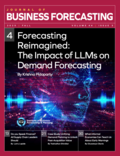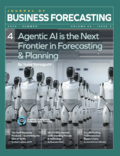 Cart
(0)
Sign In
Cart
(0)
Sign In
1486
Articles Available
Large Language Models (LLMs) offer a conversational approach to planning. Such LLMs, trained on internal and external data, don’t just provide forecasts but can answer questions such as why demand
dropped in a particular region, and provide scenario plans if a given event were to occur. Further, they can provide a rationale for their forecasts, making this a highly interactive tool that facilitates deep understanding of demand drivers. In this article, I discuss how LLMs learn from human overrides and analyze data including emails, campaign notes, and disruption alerts that traditional models overlook. I also discuss the practical applications of LLMs in retail, apparel, consumer goods, and logistics that are driving real-world operational efficiency.
Fall 2025
4
The proliferation of systemic volatility has stretched the capabilities of traditional Advanced Planning Systems which, despite their optimization power, were not designed for today’s highly dynamic and data-rich environment. This article posits that agentic artificial intelligence represents the next evolutionary step, shifting the paradigm from human-led optimization to AI-driven autonomous action. I present a practitioner’s guide for successful implementation, including a strategic matrix to help leaders select high-value use cases and validate genuine agentic capabilities. I also discuss how the role of the Supply Chain Planner must evolve from system operator to a strategic conductor of an AI-powered enterprise.
Fall 2025
4
I recently attended an IBF New England Chapter meeting where a manager discussed the S&OP process at her company which was having difficulty convincing colleagues in finance to assess whether demand-supply plans were aligned with annual financial performance targets. In this article, I discuss my response to her, namely that if supply chain managers want to get buy in from finance and executive leadership, they must speak their language—that is, in dollars and cents. I introduce the Dupont Model of Return-on-Assets (ROA) as a blueprint to use when developing a financially-oriented business case, which can effectively present demand and supply plans in financial terms, and facilitate involvement of finance colleagues.
Fall 2025
3
In this article, I provide a practical guide to building up and managing safety stocks, drawing from my hands-on experience with a high-tech client. I emphasize the importance of aligning statistical models with operational realities, and share insights into navigating the complexities of different safety stock types— statistical, factory-requested, and strategic—through a clear, well-maintained policy. I address practical elements that made the implementation both sustainable and successful, such as cross-functional coordination, effective communication, and managing workload.
Fall 2025
4
This article details how a global medical devices manufacturer faced significant challenges
integrating its expanded supply chain network following a major acquisition. I reveal the challenges involved in such a merger, including tripling the product portfolio and expanding the distribution footprint from a few regional centers to over 30 global warehouses. This case study explores how the organization redefined its demand management and forecasting processes to enable scalable, efficient planning across the new enterprise structure, thereby unlocking post-acquisition value.
Fall 2025
5
In this article I present a case for using real-time search spikes and other unstructured data as early indicators of operational risk. It highlights how terms like “fuel long queue” or “black market dollar rate”
can precede formal disruptions in supply and demand. I introduce a tool under development designed to translate publicly available data into proactive disruption alerts, especially for users in low-data or informal environments. By mapping search trends to operational risks like fuel shortages, border closures, or protests, the tool offers a practical, accessible alternative to traditional reactive models.
Fall 2025
3
In this article, I discuss my approach to planning – not demand or supply planning, but something just as critical: my own career development. Through a mix of hands-on project work, certifications, formal education, mentorship, and a healthy dose of self-initiated learning, I have taken deliberate steps to
shape a future in operational leadership. While I am the first to admit I am far from finished, I reveal how building a flexible, methodical roadmap – complete with taking time to stop and smell the roses – can turn uncertainty into momentum and ambition into action.
Fall 2025
3
Consensus expects GDP growth to rise 1.39% from Q4 2025 to Q3 2026, reflecting a general belief
in continued, though modest, economic expansion. Wells Fargo, however, projects a weaker second half of 2025, citing mounting uncertainty, persistent price pressures, and a trade policy still in flux. They also note that business spending has shifted toward intellectual property rather than equipment and structures.
Fall 2025
7
Generative AI (Large Language Models that analyze large data sets and create outputs for various applications) have taken hold across many industries and disciplines, including Supply Chain Management. The next frontier in AI technology is Agentic AI that goes beyond creating outputs to manage processes independently, such as gathering and managing data and connecting different platforms and business functions. In this article, I reveal how agentic AI can combine with generative AI to build a framework that facilitates the integration of all required information, people, technology and processes to create digital twins that perform scenario planning and generate forecasts. The challenges of building such a framework are shared, along with the ‘human’ competencies these models must possess to be effective in a VUCA environment.
Summer 2025
6
The tariffs on goods coming into the USA are creating great uncertainty regarding the cost of materials and product price inflation. Even if a tariff percentage is known, it can be difficult to quantify the impact on the cost to build or assemble a product across wide portfolio of SKUs. The Finance & Accounting function is an invaluable asset in assessing the costs associated with tariffs. In this article, I reveal how a team lead by your company’s Cost Accountant can identify the direct costs associated with tariffs on each product, create iterative scenario models that allow for different assumptions, and lay the groundwork for contingency action plans that allow for effective cost control responses.
Summer 2025
3
My last column, “Strategic Planning for Global Supply Chains in a Fragmented World” was written to advise managers regarding recent tariff initiatives. This article seeks to explain how we got here, and what incentivized executives to outsource to the Far East. I reveal how a focus on financial metrics like Return on Assets has driven the move to outsourcing at the cost of American workers and in-house manufacturing expertise that, once outsourced, is difficult to regain. Strategic downsides to such moves are discussed, including the tendency for foreign countries to acquire the Intellectual Property of outsourcing countries and replicating their products, as well the risk of critical supply shortages the likes of which were seen during COVID.
Summer 2025
3
With thousands of new book launches per year, forecasting demand in the book publishing industry is challenging. Finding the balance between meeting market demand and avoiding the costs of unsold inventory requires a robust planning process that incorporates industry knowledge, cross-functional involvement, and advanced forecast modeling. In this article, I reveal the approach used by a global publishing giant behind some of the world’s most popular books. I detail how publishers are responding to new market dynamics like spikes in demand caused by TikTok influencers, and how we are building new models that combine internal and external comparable sales data, POS data, lead times, and publicity-driven spikes.
Summer 2025
4
In today’s complex business environment, Sales and Operations Planning (S&OP) is evolving from a tactical coordination tool into a strategic, AI-supported framework for organizational alignment. This article examines how ERP platforms, collaborative planning tools, and predictive analytics underpin an effective S&OP process. From enhancing forecast accuracy to improving agility during disruptions, we explore how technology can make S&OP more dynamic, resilient, and impactful. Special attention is paid to how ERP systems function and how they support various aspects of the planning process.
Summer 2025
4
Is AI changing hiring trends? Companies are certainly interested in hiring AI-related team members. However, those roles tend to be more stand-alone positions in support of other functions. For example, one client of ours hired a Data Scientist specifically to aid the demand planning team. In some organizations, these resources act as a shared service across the business. In larger businesses, these resources will specialize in working with a specific team, sometimes as part of a Center of Excellence.
Summer 2025
3
Future-proofing pharmaceutical supply chains is critical in an increasingly complex and unpredictable business environment. While redesigning the asset footprint is often impractical due to high costs and stringent regulations, pharmaceutical companies can ensure their supply chain is future-ready by selecting a fit-for-purpose technique. This article explores three data-driven strategies of future-proofing supply chains in the pharmaceutical industry: scenario modelling, allocation optimization, and capacity expansion – along with illustrative examples based on real-life projects in the Life Science industry.
Summer 2025
3
Customer service is not always included in S&OP, but it should be. This often over- looked function has insight into customer behavior and issues that salespeople do not, and can highlight factors impacting demand that help us to plan better. This qualitative insights allows us to refine statistical forecasts for more accurate demand plans. In this article I reveal five reasons to include customer service in your planning meetings, including identifying their seasonal buying behavior, highlighting upcoming promotions and events, and revealing whether individual customers are ahead or behind the planned sales volumes.
Summer 2025
3









